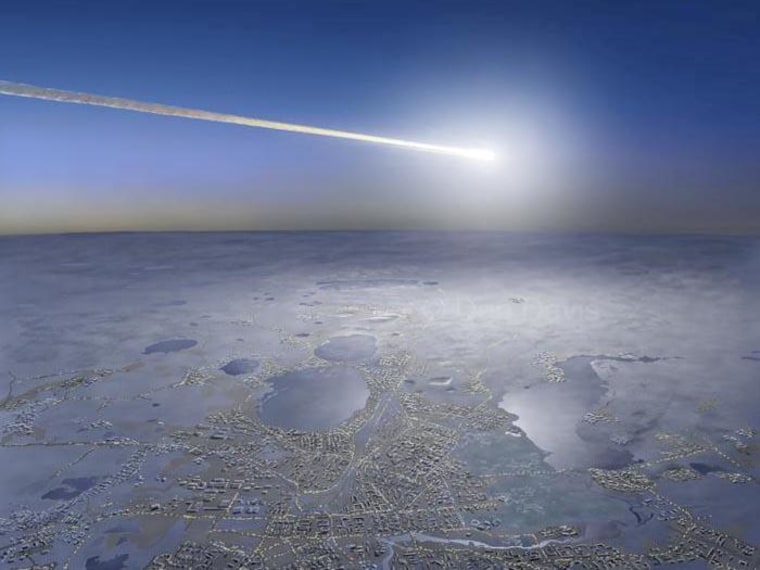Congress got the word from NASA on Tuesday about its options for dealing with the threats posed by asteroids and comets: Lawmakers can either provide adequate funding for detecting and characterizing near-Earth objects, and diverting them if necessary — or they can pray.
Threats from space are generally the stuff of science-fiction movies such as "Armageddon" and "Deep Impact," but members of the House Science Committee took a hard look at the realities during Tuesday's hearing, which came in response to the Feb. 15 meteor explosion over Russia as well as a close encounter that same day with a much bigger asteroid known as 2012 DA14.
The lawmakers didn't always like what they heard. The committee's chairman, Rep. Lamar Smith, R-Texas, told the panelists more than once that the progress report they delivered was "not reassuring." But representatives from both parties were receptive to the idea of putting more resources into the effort to counter cosmic threats.
White House science adviser John Holdren noted that the funding devoted annually to cataloging potentially threatening asteroids has risen from $5 million to more than $20 million over the past couple of years. But even at that level, NASA Administrator Charles Bolden estimated that it would take until 2030 to catalog 90 percent of the near-Earth objects between 140 meters and 1 kilometer in width, as mandated by Congress.
"Maybe we can help you out with the budget. Don't know," Smith replied. He said "we need to find ways to prioritize NASA's projects."
Holdren said the single most useful project would be to put an infrared-sensing telescope in a Venus-like orbit, like the Sentinel Space Telescope being developed by the nonprofit B612 Foundation. The telescope could look for asteroids that currently can't be spotted from the ground because they spend much of their time within Earth's orbit, where they're lost in the sun's glare. The 55-foot-wide (17-meter-wide) rock that blew up without warning over Chelyabinsk in Russia last month was just such an asteroid.
"It came from a direction where our [existing] telescopes could not look," Holdren said. "We cannot look in the sun."

Holdren estimated the cost of an asteroid-hunting space telescope at $500 million to $750 million, and said it could reduce the congressionally mandated survey time to six to eight years. Following through on the Obama administration's plan to send astronauts to a near-Earth asteroid by 2025 would cost about $2 billion a year, Holdren said.
The automatic spending cuts known as sequestration will affect NASA's asteroid-hunting effort as well as the plans for human exploration, Bolden warned.
"The president has a plan. But that plan is incremental," Bolden said, referring to the Obama administration's budget proposal. "And if we want to save the planet, because I think that’s what we’re talking about, then we have to get together ... and decide how we’re going to execute that plan."
The idea of enlisting other countries as well as amateur astronomers to "crowdsource" the hunt for threatening asteroids struck a responsive chord with lawmakers. But Rep. Dana Rohrabacher, R-Calif., reminded Bolden that China couldn't be on the list of partners due to a congressional ban.
Congressional teach-in
The hearing served as a teach-in for some of the panel members. At one point, Rep. Randy Weber, R-Texas, asked whether the $8.8 billion James Webb Space Telescope could be retrofitted to look for asteroids. "No, sir," Bolden replied. At another point, Gen. William Shelton, head of the Air Force Space Command, had to explain to lawmakers that the space-based surveillance system used for monitoring missile launches on Earth could not watch out for rocks coming in from deep space.
Holdren and Bolden provided a status report on the asteroid search, reporting that about 95 percent of the near-Earth objects larger than a kilometer are being tracked. However, only about 10 percent of the 13,000 to 20,000 asteroids bigger than 140 meters have been detected. If an asteroid of that size were to strike land, it "could devastate the better part of a continent," Holdren said.
Looking on the bright side, Holdren added that such asteroids are thought to hit Earth only every 20,000 years or so.
Bolden said less than 1 percent of the space rocks in the 30- to 100-meter range have been found. Such asteroids may not be continent-killers, but they are bigger and more potentially destructive than last month's Chelyabinsk meteor.
Lawmakers repeatedly asked how much advance warning would be required to deflect a threatening asteroid, and were repeatedly told that it would take years. Shelton said that if time was limited, "probably nuclear energy is what we're talking about." But even a nuclear-armed mission to blast an asteroid, Bruce Willis-style, would require lots of lead time. Rep. Bill Posey, R-Fla., asked Bolden about the strategy for dealing with an Earth-threatening asteroid that was discovered with three weeks' warning.
"If it's coming in three weeks ... pray," Bolden said. "The reason I can't do anything in the next three weeks is because for decades we have put it off."
More about threats from space:
- 'Marsageddon' comet adds to concerns
- The global plan to deal with asteroids
- Cosmic Log archive on asteroids
Ali Weinberg is an associate producer with NBC News in Washington.
Alan Boyle is NBCNews.com's science editor. Connect with the Cosmic Log community by "liking" the log's Facebook page, following @b0yle on Twitter and adding the Cosmic Log page to your Google+ presence. To keep up with Cosmic Log as well as NBCNews.com's other stories about science and space, sign up for the Tech & Science newsletter, delivered to your email in-box every weekday. You can also check out "The Case for Pluto," my book about the controversial dwarf planet and the search for new worlds.